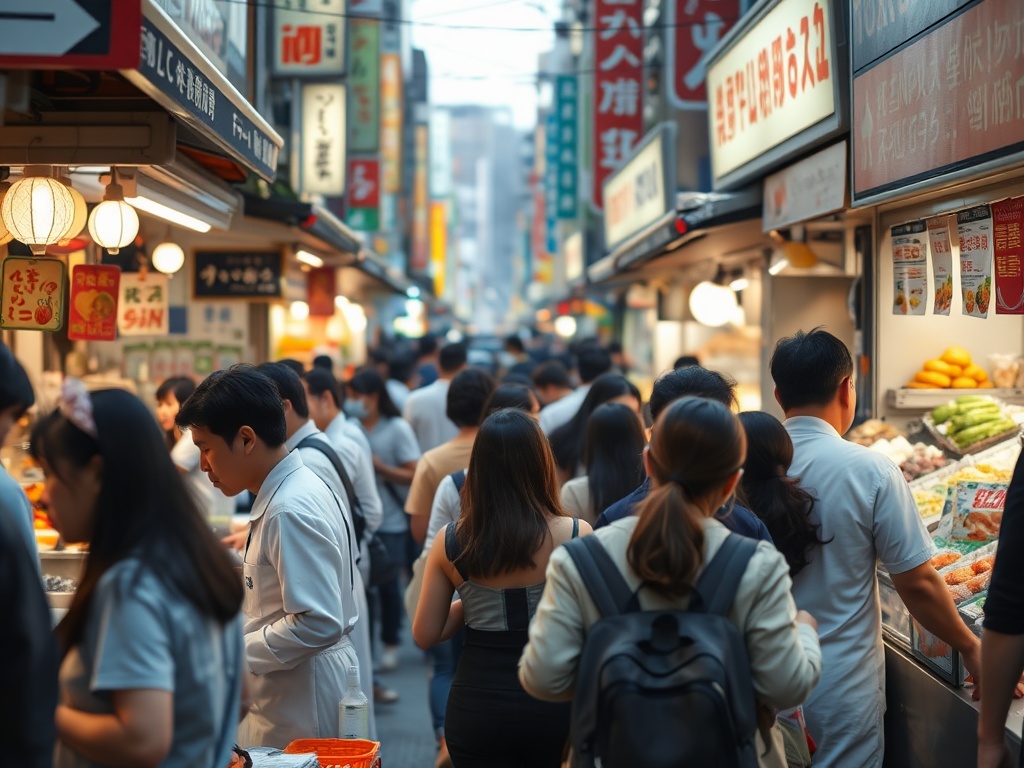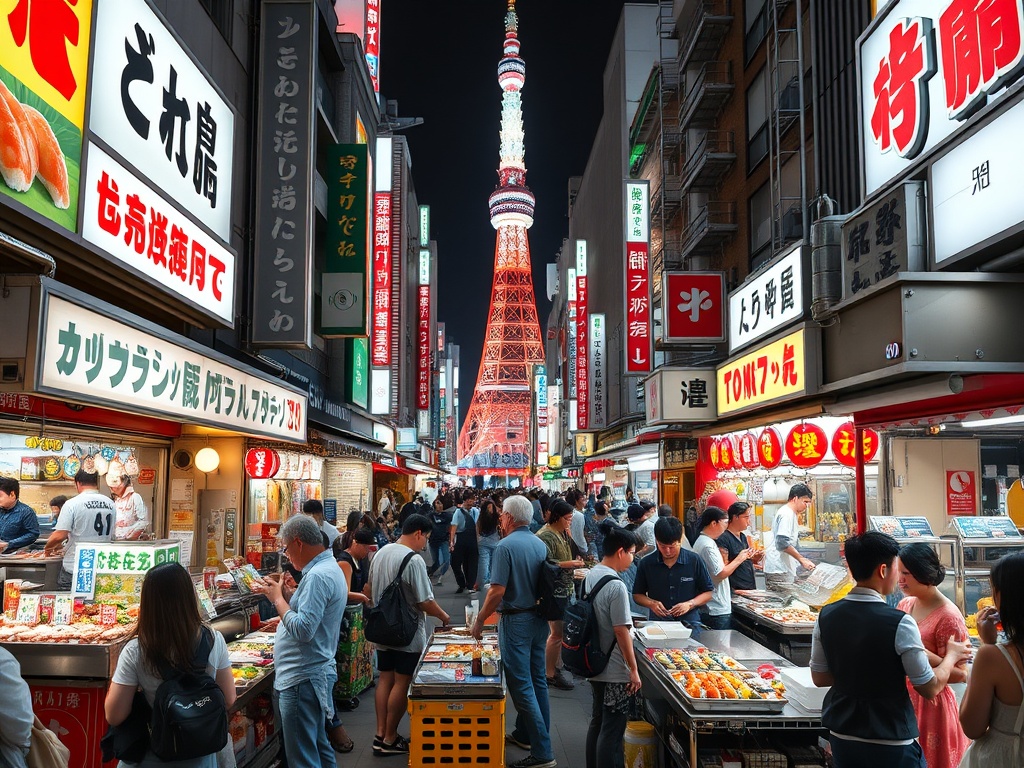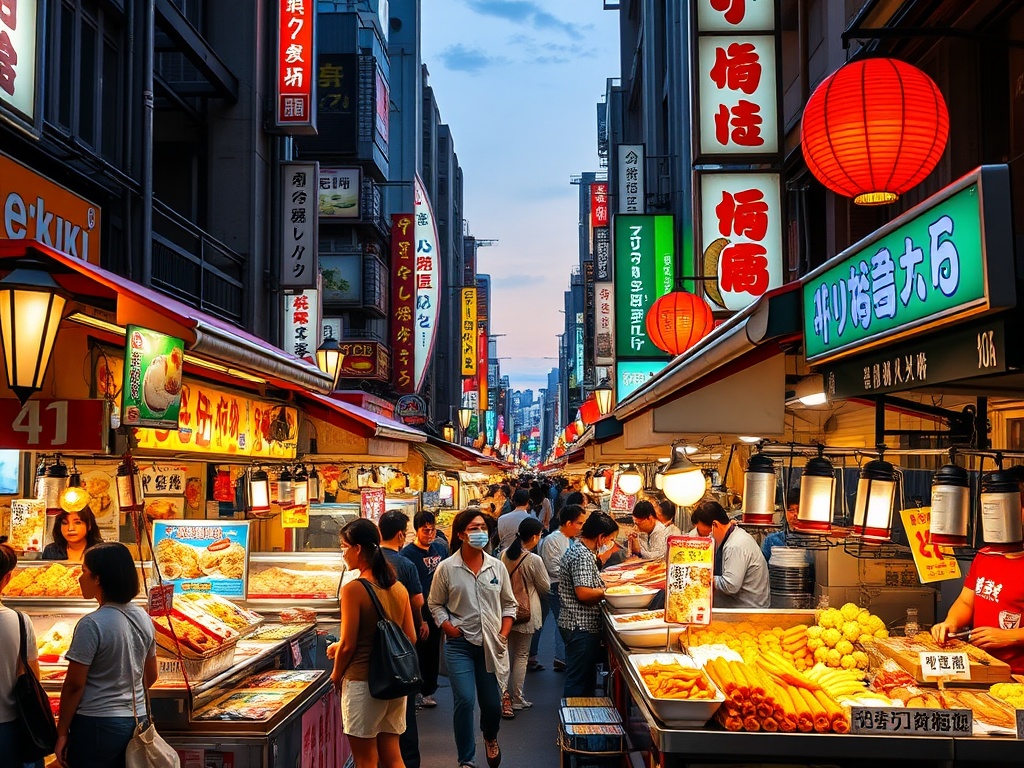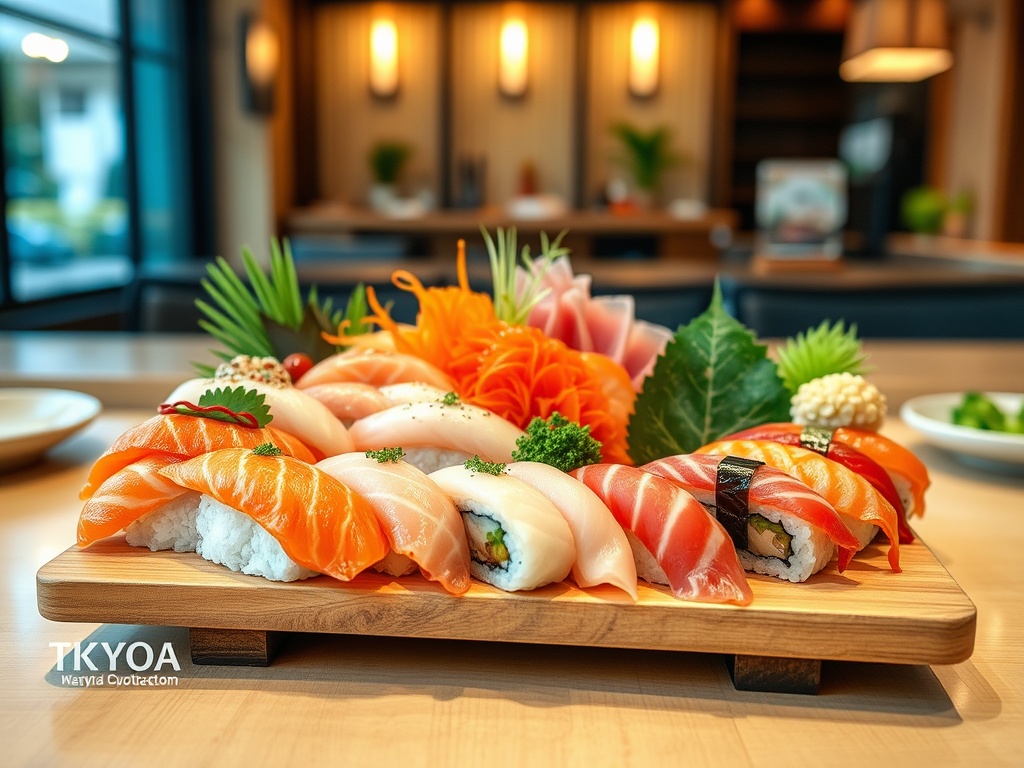Navigating Tokyo’s Culinary Wonderland: Staying Safe in Japan’s Food Heaven
Win a Free Trip to Japan!
Experience cherry blossoms and ancient temples
Tokyo, a vibrant city known for its eclectic mix of tradition and modernity, is also a foodie’s paradise. From sushi to ramen, the culinary experiences are endless. However, for any travel and tourism enthusiast, ensuring food safety is a priority to fully enjoy the gastronomic delights of this bustling metropolis.
The allure of Tokyo’s street food is undeniable, with tantalizing aromas wafting through the air of bustling markets and narrow alleyways. While indulging in yakitori or takoyaki, it’s crucial to prioritize safety. Opt for stalls that are crowded with locals and have high turnover, as this is a good indicator of fresh ingredients and reliable preparation practices.
Here’s a quick checklist to ensure your street food adventure is both delicious and safe:
- Observe Cleanliness: Choose vendors with clean cooking areas and hygienic handling.
- Watch for Freshness: Food should be cooked fresh and served hot.
- Check for Local Patronage: Popular stalls frequented by locals are typically safe bets.
Tokyo’s restaurants range from humble izakayas to Michelin-starred establishments. Regardless of where you dine, understanding the local etiquette and hygiene practices can enhance your dining experience. Many restaurants display their health inspection certificates, an assurance of adherence to safety standards.
When dining out, keep these points in mind:
- Reservation Recommendations: High-end restaurants often require reservations. Plan ahead to ensure you’re not left out.
- Utensil Usage: Use the communal serving spoons provided, and avoid using your own chopsticks when reaching for shared dishes.
- Trust the Chef: At sushi bars, trust the chef’s expertise in serving the freshest fish.
Tokyo offers a plethora of options for those with dietary restrictions. Whether you’re vegetarian, vegan, or gluten-free, understanding how to communicate your needs is essential. Many restaurants now provide English menus or staff who speak basic English, but carrying a translation card for specific dietary terms can be helpful.
Consider these tips for managing dietary needs effectively:
- Research Ahead: Identify restaurants that cater to your dietary needs before arrival.
- Use Technology: Leverage translation apps to communicate your dietary preferences clearly.
- Be Open: While Tokyo is accommodating, be prepared for limited options in traditional establishments.
Street Food Secrets: How to Enjoy Tokyo’s Outdoor Eats Without a Worry
Tokyo’s street food scene is a vibrant tapestry of flavors and experiences that every travel enthusiast should explore. With its bustling markets and hidden alleyways, the city offers a delightful culinary adventure. However, while the street food journey is exciting, ensuring food safety is paramount to enjoying your trip to the fullest. By following a few simple guidelines, you can savor Tokyo’s outdoor eats without a worry.
Embarking on a street food adventure in Tokyo requires a keen eye and a few insider tips. Understanding the nuances of the local scene will not only keep you safe but also enhance your culinary experience.
Street Food Safety Checklist
- Look for Busy Stalls: High foot traffic is a good indicator of fresh and popular food.
- Check the Cooking Process: Watch how food is prepared and ensure it is cooked thoroughly.
- Observe Vendor Hygiene: Notice if vendors use gloves and keep their workspaces clean.
- Trust Your Senses: Use your sense of smell and sight to judge the freshness of ingredients.
As you navigate Tokyo’s street food offerings, familiarize yourself with some local favorites to make informed choices. From savory delights to sweet treats, each dish brings a unique taste of Tokyo’s culinary culture.
| Dish | Description | Safety Tip |
|---|---|---|
| Takoyaki | Ball-shaped snacks filled with octopus, tempura scraps, and pickled ginger. | Ensure they are served hot and freshly made. |
| Yakitori | Skewered chicken grilled over charcoal. | Choose vendors who cook to order, ensuring meat is well-cooked. |
| Taiyaki | Fish-shaped pastries filled with sweet red bean paste. | Opt for stalls where pastries are freshly baked. |
Part of the thrill of street food is the unexpected discoveries you make along the way. While safety should always be a priority, don’t be afraid to step out of your comfort zone and try something new. Tokyo’s street food scene is a playground for adventurous eaters, offering unique and memorable experiences.
Sushi and Safety: Ensuring Freshness in the Land of Raw Delicacies
Tokyo’s reputation as a sushi haven is well-deserved, with its rich legacy of crafting this beloved delicacy. For travelers, indulging in sushi is a quintessential Tokyo experience, yet it’s essential to prioritize safety to enjoy these raw treasures without concern. Sushi, being a raw delicacy, demands the highest standards of freshness and hygiene.
To ensure that your sushi experience is both delightful and safe, it’s crucial to recognize the hallmarks of freshness. In Tokyo, sushi is more than just food; it’s an art form, and chefs take immense pride in the quality of their offerings. Pay close attention to the following when selecting a sushi spot:
- Glance at the Counter: Fresh fish should have a vibrant color and a clean, mild scent. If it looks dull or smells fishy, it’s best to avoid it.
- Observe the Sourcing: Many reputable sushi restaurants source their fish daily from Tsukiji or Toyosu markets. Asking about the source of the fish can give you confidence in its freshness.
- Seek Expert Recommendations: Locals know the best spots. A recommendation from a Tokyo native is often a guarantee of quality and safety.
While Tokyo offers a range of sushi experiences, from standing sushi bars to upscale omakase, making informed choices can enhance both the safety and enjoyment of your meal. Consider these different experiences:
- Standing Sushi Bars: These casual spots are perfect for a quick, authentic bite. Opt for those with high turnover and visible preparation areas to ensure freshness.
- Omakase Dining: Trust in the chef’s selection and expertise. Omakase often involves a personal touch, with chefs serving seasonal and impeccably fresh fish.
Armed with knowledge and a discerning eye, you can savor Tokyo’s sushi offerings with confidence. Whether you’re a seasoned sushi aficionado or a curious first-timer, Tokyo presents an unparalleled journey into the world of raw delicacies. So, dive in and let your taste buds revel in the authentic flavors of Japan’s iconic cuisine, knowing you’ve prioritized safety every step of the way.
Dining Out in Tokyo: Decoding Menus and Avoiding Allergens
Dining out in Tokyo is an adventure that promises a feast for the senses. However, for travelers with dietary restrictions or allergies, the language barrier can pose challenges. Navigating Tokyo’s diverse culinary landscape requires awareness and preparation to ensure a safe and enjoyable dining experience. With a little foresight, you can savor Tokyo’s epicurean delights without worry.
Most Tokyo restaurants have menus that might initially seem overwhelming, but fear not! Familiarizing yourself with common menu symbols and terms can simplify the ordering process. Look for icons indicating vegetarian, vegan, or gluten-free dishes. Additionally, understanding basic Japanese food terms can greatly aid in deciphering the menu.
Here’s a short guide to help you navigate:
- Vegan/Vegetarian: Look for terms like “ビーガン” (biigan – vegan) or “ベジタリアン” (bejitarian – vegetarian).
- Gluten-Free: Seek out “グルテンフリー” (guruten furii).
- Common Allergens: Be aware of terms like “乳” (nyuu – dairy), “卵” (tamago – egg), and “ナッツ” (nattsu – nuts).
Communication is key when dealing with food allergies. Many restaurants in Tokyo are becoming increasingly aware of various dietary needs, but it’s always wise to ensure your requirements are clearly understood. Carrying a printed allergy card in Japanese can be a lifesaver, explaining your allergies in detail to restaurant staff.
Consider these tips for effective communication:
- Use Translation Apps: These can help bridge language gaps, especially for complex dietary restrictions.
- Allergy Cards: Prepare a card in Japanese detailing your specific allergies and dietary needs.
- Seek Staff Assistance: Politely ask staff if they can accommodate your dietary restrictions; most will be eager to help.
While navigating dietary needs in a foreign land can be daunting, Tokyo’s vibrant food scene is worth the effort. Armed with the right tools and knowledge, you can explore with confidence, tasting the very best the city has to offer. Embrace the journey, knowing you’ve taken the necessary steps to ensure both your safety and enjoyment. Let each meal be a discovery, a delicious chapter in your Tokyo adventure.
Smart Snacking: Choosing Packaged Food with Confidence in Tokyo
Tokyo is a city where culinary adventures extend beyond street stalls and Michelin-starred restaurants. For travelers on the go, packaged snacks offer a convenient and often intriguing glimpse into Japanese flavors. However, ensuring that these pre-packaged delights are safe to consume is crucial for a worry-free experience. With a keen eye and some insider knowledge, you can confidently navigate Tokyo’s grocery stores and convenience shops, making the most of your time in this gastronomic wonderland.
In Tokyo, the array of packaged snacks is both vast and diverse, ranging from savory rice crackers to sweet mochi treats. Yet, for those unfamiliar with the language, deciphering ingredient lists can be daunting. Look for familiar brand names that often provide English translations on their packaging. If you’re unsure, translation apps can be invaluable tools for understanding key ingredients and potential allergens. It’s also helpful to recognize common Japanese food terms that might appear on labels, such as “砂糖” (sugar) or “塩” (salt).
Tokyo’s convenience stores, or konbini, are treasure troves of unique and delicious snacks. From onigiri rice balls to matcha-flavored goodies, these stores offer a wide selection that caters to all tastes. For the discerning traveler, it’s important to choose items that are well-packaged and within their expiration dates. The convenience store staff are generally helpful and can assist if you have questions about product freshness or dietary content. Don’t hesitate to ask for recommendations—some of the best local snack experiences come from a friendly tip.
While the thrill of trying new snacks is part of the Tokyo experience, maintaining a balance between adventure and safety is essential. Opt for brands known for their quality and standards, as these are more likely to adhere to stringent safety regulations. It’s equally important to consider your own dietary restrictions and preferences, ensuring that your snacking adventures are both enjoyable and safe. By making informed choices, you can savor the unique flavors of Tokyo’s packaged snacks, adding another layer to your culinary journey.
Hydration in the Metropolis: Drinking Water Safety Tips for Tokyo Travelers
Tokyo, with its towering skyscrapers and neon-lit streets, is a city that never sleeps. As you navigate through this bustling metropolis, ensuring you stay hydrated is just as important as savoring its culinary delights. While the food scene offers a feast for the senses, understanding the nuances of drinking water safety will enhance your Tokyo adventure.
One might wonder about the safety of tap water in such a vast city. Rest assured, Tokyo’s tap water is among the safest in the world. The city’s stringent purification standards ensure that every drop is clean and safe for consumption. As you explore the city’s vibrant neighborhoods, feel free to refill your water bottle at public drinking fountains or enjoy a glass straight from the tap at your accommodation.
Beyond tap water, Tokyo offers a plethora of unique hydration options that are both refreshing and intriguing. Visit any of the city’s ubiquitous vending machines, and you’ll find a dazzling array of beverages. From matcha-infused teas to vitamin-packed sports drinks, there’s something for every palate. These convenient options are perfect for travelers on the go, ensuring you stay hydrated as you explore.
For those seeking a more traditional experience, Tokyo’s tea houses offer a serene escape. Enjoy a cup of freshly brewed green tea, known for its antioxidant properties and subtle flavors. Whether you’re savoring a cup in a tranquil garden or a bustling café, tea is an integral part of the Tokyo experience.
While tap water is safe, many travelers prefer the convenience of bottled water. Tokyo’s convenience stores are stocked with a variety of brands, each offering different mineral compositions. When choosing bottled water, look for brands with the label “天然水” (natural water), indicating a high standard of purity. Understanding these labels can help you make an informed choice, ensuring you stay hydrated without compromising on safety.
In addition to bottled water, consider trying the local specialty drinks. Tokyo’s supermarkets often carry an array of flavored waters and health-focused beverages, providing an opportunity to sample the city’s innovative approach to hydration. Remember, staying hydrated is key to enjoying all that Tokyo has to offer, from its culinary wonders to its cultural landmarks.
From Farm to Table: Understanding Japan’s Food Supply Chain for Travelers
For travelers stepping into Tokyo’s vibrant food scene, understanding the journey of food from production to your plate is not just fascinating—it’s essential for ensuring a safe dining experience. Japan’s commitment to quality and safety in its food supply chain is a testament to its culinary reputation. With a seamless blend of tradition and cutting-edge technology, the country maintains high standards that protect consumers and highlight the purity of its ingredients.
Japan’s agricultural practices are deeply rooted in the philosophy of harmony with nature. The country’s farmers prioritize sustainable methods, ensuring that the produce is not only fresh but also free from harmful chemicals. Government regulations enforce strict pesticide controls and emphasize organic farming, ensuring what arrives at Tokyo’s markets is of the highest quality. This dedication to sustainable agriculture means travelers can savor everything from juicy melons to crisp greens with confidence.
Beyond the farm, Japan’s food distribution network is a marvel of efficiency. The integration of advanced logistics and technology ensures that food travels swiftly from rural fields to urban eateries. This minimizes the time between harvest and consumption, maintaining the freshness and flavor that Tokyo’s cuisine is famed for. As a traveler, understanding this supply chain underscores the reliability and safety of the meals served in the city’s bustling restaurants.
Tokyo’s local markets offer a glimpse into the heartbeat of its food culture, where freshness and tradition meet modern demand. Exploring these markets allows travelers to see firsthand the quality checks and handling practices that preserve food safety. Vendors take pride in displaying their goods, often sharing insights into their origins and preparation methods. This transparency not only builds trust but also enriches your culinary journey, giving you a deeper appreciation for the care taken at every step of the supply chain.
Many restaurants in Tokyo emphasize a ‘market to table’ approach, sourcing ingredients daily from renowned markets like Tsukiji and Toyosu. This practice ensures that dishes are prepared with the freshest produce, adhering to the high standards expected by locals and visitors alike. Whether dining at a sushi bar or a traditional izakaya, travelers can indulge in Tokyo’s gastronomic delights with peace of mind, knowing the origins and handling of their meal.
Cultural Etiquette: Respecting Food Safety Practices in Tokyo’s Restaurants
Tokyo’s vibrant culinary landscape is deeply intertwined with its cultural etiquettes. For travelers eager to immerse themselves in the city’s gastronomic offerings, understanding and respecting local food safety practices is not just about personal well-being, but also about honoring the rich traditions that make Tokyo’s dining experiences unique. By embracing these cultural nuances, you can enhance your dining adventure, ensuring it is both safe and respectful.
In Tokyo, the attention to detail in food preparation and presentation is a reflection of the Japanese respect for hygiene and order. Upon entering a restaurant, it is common to be offered a warm, moist towel, known as an oshibori, to cleanse your hands before your meal. This simple ritual underscores the importance of cleanliness in dining settings and sets the stage for a mindful eating experience. Observing and participating in these practices not only ensures personal hygiene but also aligns with the local customs.
Another aspect to consider is the presentation of food. In Japan, the aesthetic appeal of a dish is considered as crucial as its taste. Chefs meticulously arrange each component to not only maximize flavor but also to showcase the freshness and quality of the ingredients. As a guest, appreciating this visual artistry and avoiding unnecessary alterations to the dish is a form of respect towards the chef’s craftsmanship.
Tokyo’s dining culture is as much about interaction as it is about the food itself. When dining at sushi bars, for instance, engaging with the chef and observing their skills can provide insights into the culinary traditions and food safety practices upheld in these establishments. Chefs often take pride in explaining the origins of the fish and the techniques used to ensure its freshness, offering a deeper connection to your meal.
Respecting local dining culture also involves understanding the communal aspects of eating in Tokyo. Sharing dishes is common, and so is the use of communal utensils to serve food from shared plates. This practice not only prevents cross-contamination but also fosters a sense of community among diners. By adhering to these customs, you contribute to a safe and enjoyable dining atmosphere.



